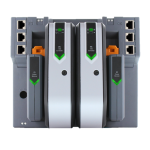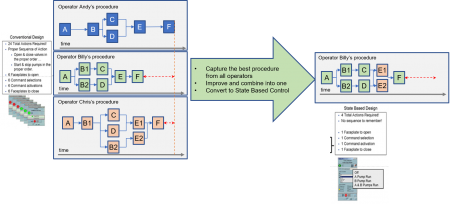For over 100 years, a large global chemicals manufacturer has been leading innovation with gases, technology and related services used by many industries worldwide. Operating at peak efficiency with minimal downtime is critical to maximizing production and profitability.
For many years, this manufacturer has operated in a more conventional method of controlling their processes. For instance, the process to start a simple pump has traditionally required over 20 separate operator actions applied in a specific sequence. And that process commonly had different procedures depending on which specific operator happened to be working on that shift, with one procedure sometimes being more efficient than another.
The company’s engineering team, working with a trusted integrator partner, began to explore how they could migrate from their traditional method of control to a system of state-based control, instead. If you’re not familiar with state-based control, it is basically a process automation design based on the concept that all process facilities should operate in recognized, definable “process states” representing a variety of normal and abnormal conditions of that process, with defined actions to take based on that state.
State-based control would allow the manufacturer to identify the best procedure for each process across all operators with the potential to improve that procedure. Once a standardized procedure was defined for each process, they could be converted to a state-based control method where most of the steps or actions in the procedure could be automated in a process controller. As such, state-based control would allow the manufacturer to greatly reduce factors of human error and inconsistency to significantly increase the efficiency of all processes.
 To that end, the engineers involved decided to implement the automation of these procedures using DeltaV’s PK Controller system. The PK Controller includes an onboard OPC UA Server for reliable, fully secure integration with their other systems. The new challenge based on that decision, however, was that they needed to also integrate the PK Controllers into their existing Foxboro DCS system.
To that end, the engineers involved decided to implement the automation of these procedures using DeltaV’s PK Controller system. The PK Controller includes an onboard OPC UA Server for reliable, fully secure integration with their other systems. The new challenge based on that decision, however, was that they needed to also integrate the PK Controllers into their existing Foxboro DCS system.
Communications with the Foxboro DCS controller was facilitated with the AIM AT OPC Server. However, the AIM server only supports OPC DA. So, the engineers needed an effective way to join OPC UA and OPC DA server technology in a seamless manner.
After researching their options and how to integrate the two systems, the engineering team discovered the Cogent DataHub. Since Cogent DataHub can act as an OPC Gateway, supporting both OPC UA client/server and OPC DA client/server interfaces, DataHub could seamlessly connect to both the PK Controllers directly and to the Foxboro DCS controller via the AIM AT OPC DA server.
Further facilitating the seamless integration of the OPC UA and OPC DA sides of the system, Cogent DataHub also includes fully configurable bi-directional point-to-point bridging, allowing the two systems to automatically share data changes as they occur. And with an integrated scripting engine, DataHub also allowed the engineers to implement smart control of the connections to the OPC UA and OPC DA systems based on the current connection status.
 So, for this project, the AIM AT OPC DA server is connected to the Foxboro DCS controller and then Cogent DataHub acting as an OPC DA client. The Cogent DataHub, through its OPC UA client interface, is then connected to the new DeltaV PK Controllers via their embedded OPC UA server interface. The Cogent DataHub then shares data from the PK Controllers with the DCS and vice-versa using the configured point-to-point bridges.
So, for this project, the AIM AT OPC DA server is connected to the Foxboro DCS controller and then Cogent DataHub acting as an OPC DA client. The Cogent DataHub, through its OPC UA client interface, is then connected to the new DeltaV PK Controllers via their embedded OPC UA server interface. The Cogent DataHub then shares data from the PK Controllers with the DCS and vice-versa using the configured point-to-point bridges.
This manufacturer has seen significant increases in plant performance after implementing this state-based control methodology when comparing post-implementation production to historical production for the same period. For example, one gas plant was projected to produce an additional 530 tons of liquid oxygen compared the same period in the prior year.
Beyond simply increased production and reduced downtime, however, this hybrid system joining OPC UA and OPC DA for state-based control also improved the overall process safety of the manufacturer’s plants by reducing the human error factor. And having a single application covering both systems has provided other benefits including reduced integration points, lower risk, a smaller cyber security attack surface and efficiencies from having fewer applications to maintain.
If you’re not familiar with Cogent DataHub but the use case above is intriguing to you and you would like to try DataHub for your own OPC UA and other integration projects, you can get a free trial of Cogent DataHub. Download Your Free Trial.
Cogent DataHub is a trademark of Cogent Real Time Systems.
Software Toolbox is a trademark of Software Toolbox, Inc.

